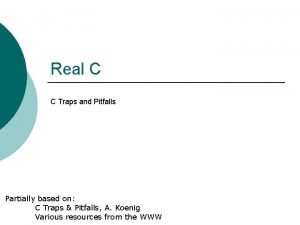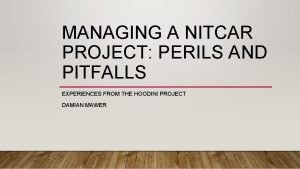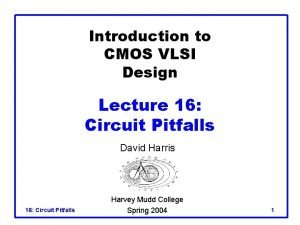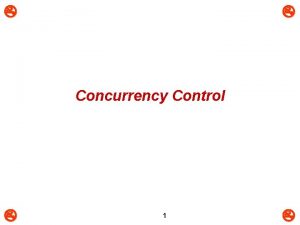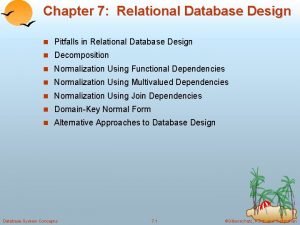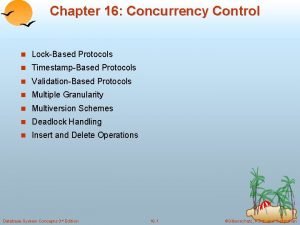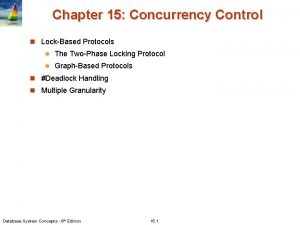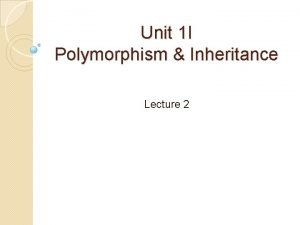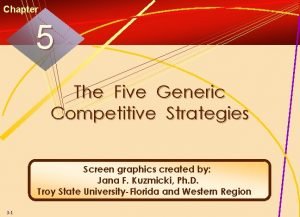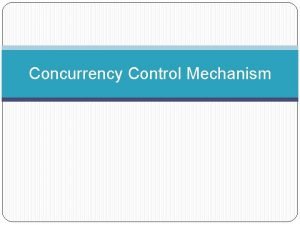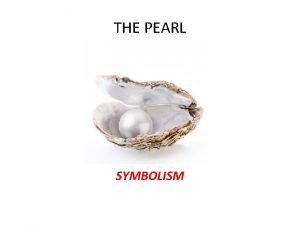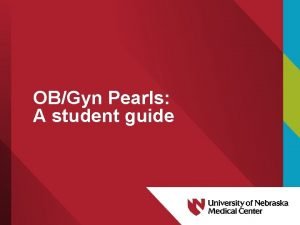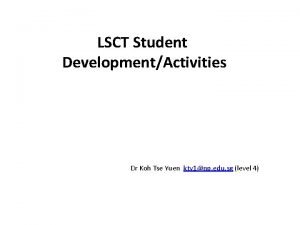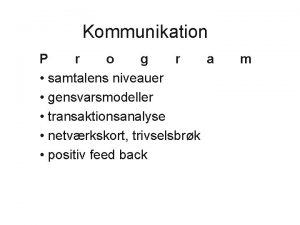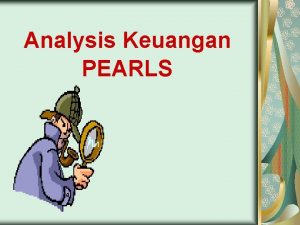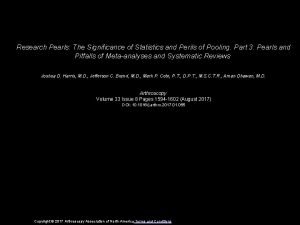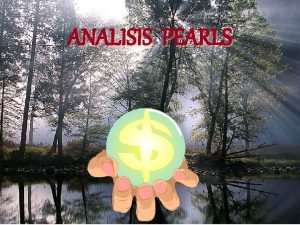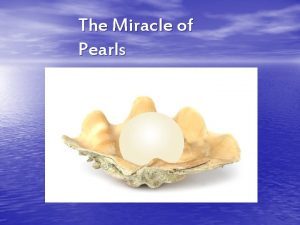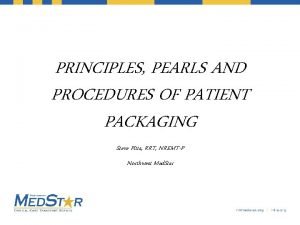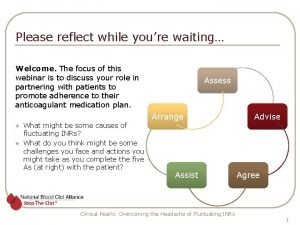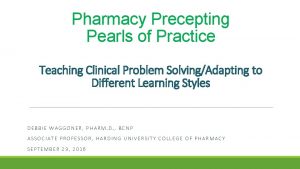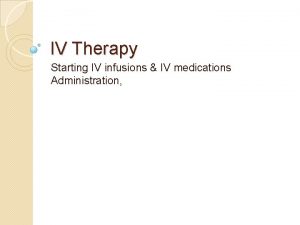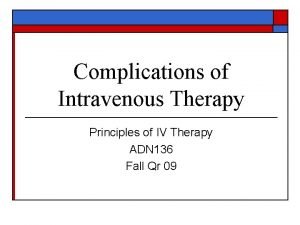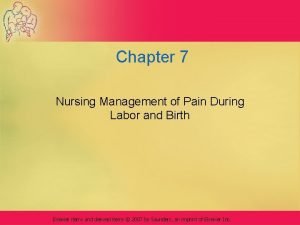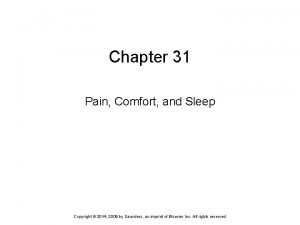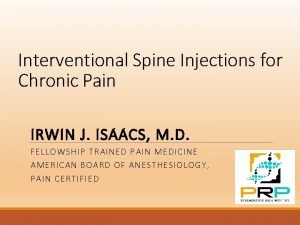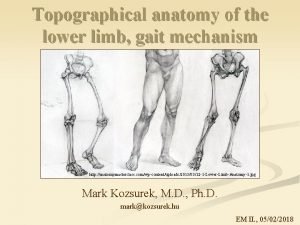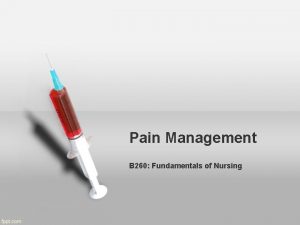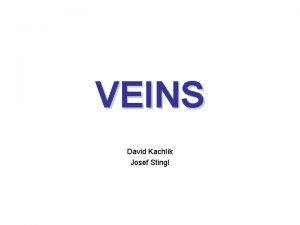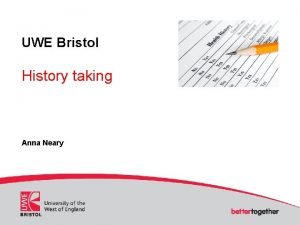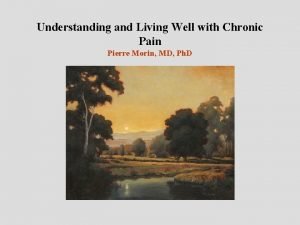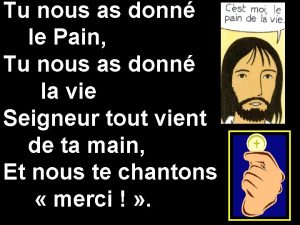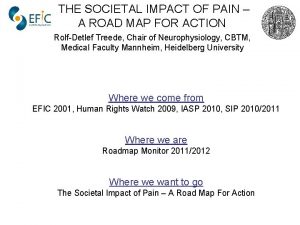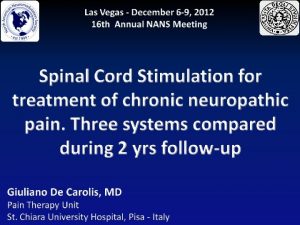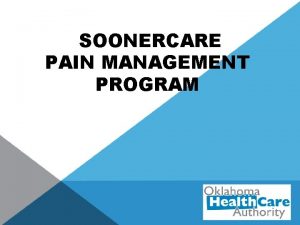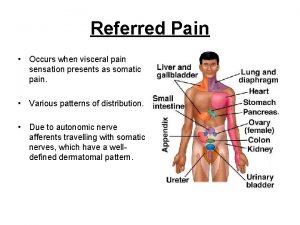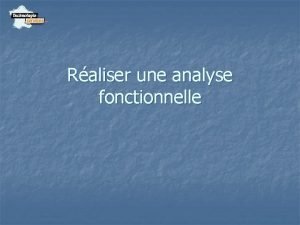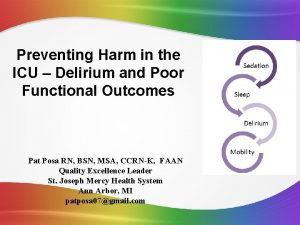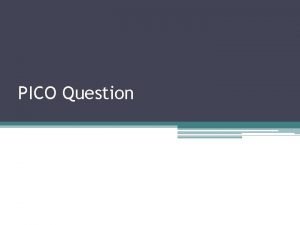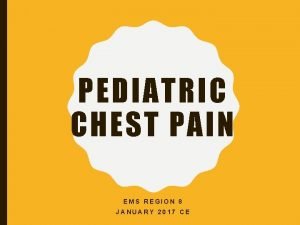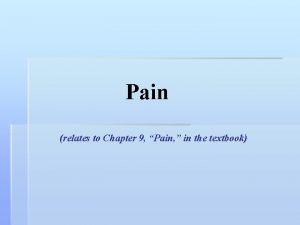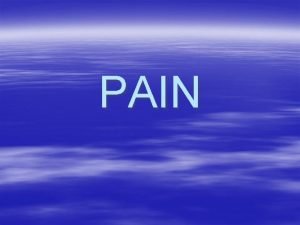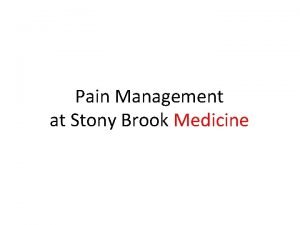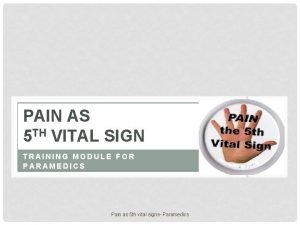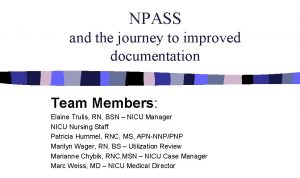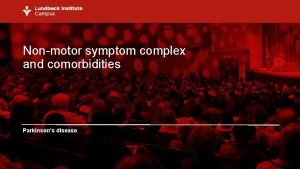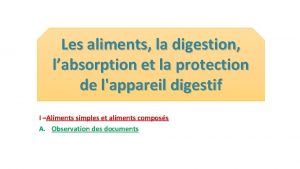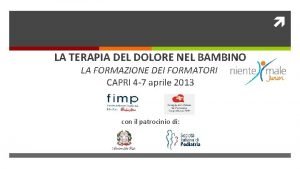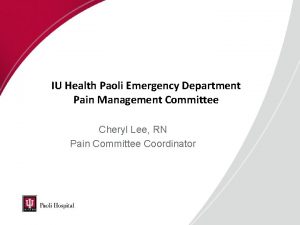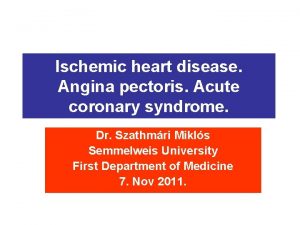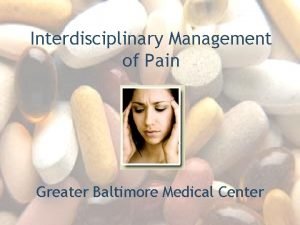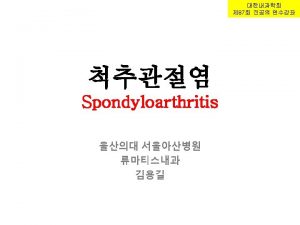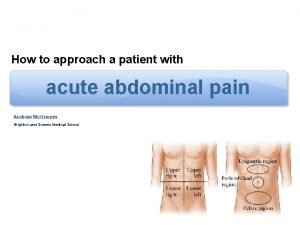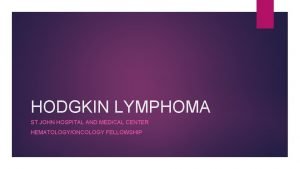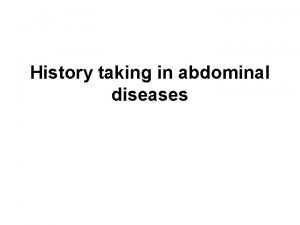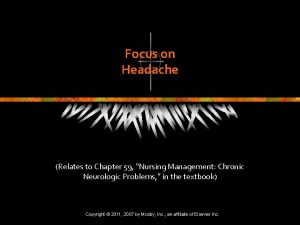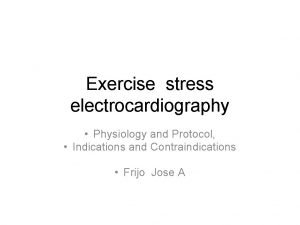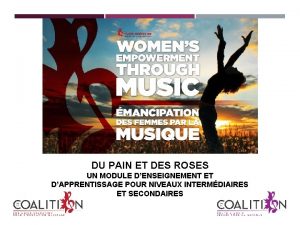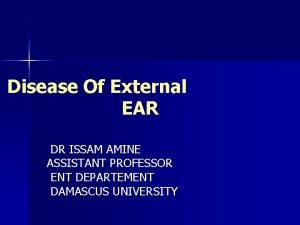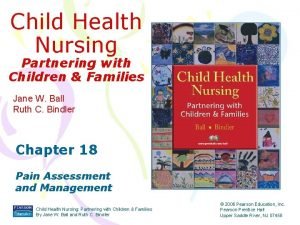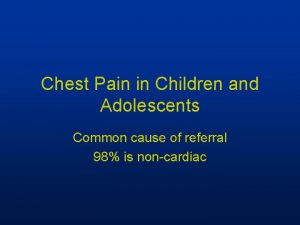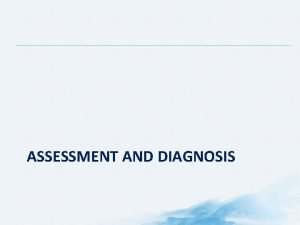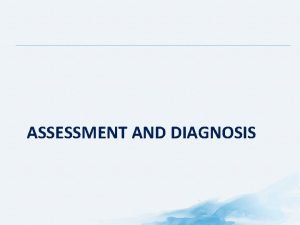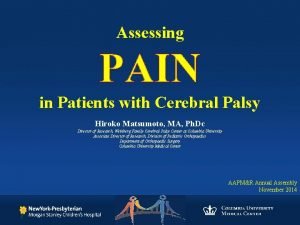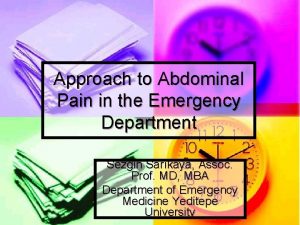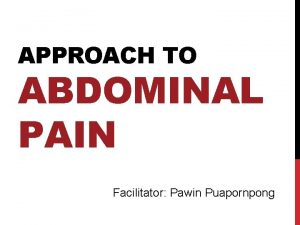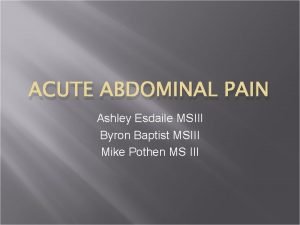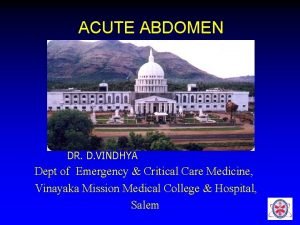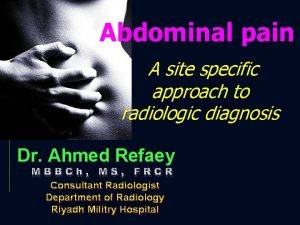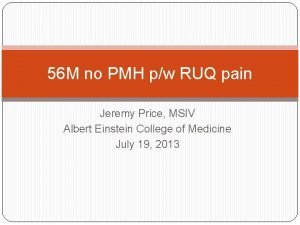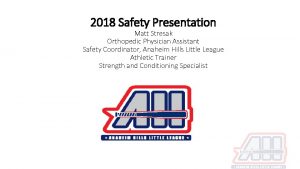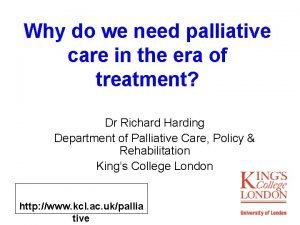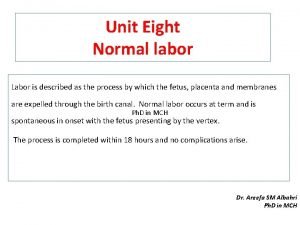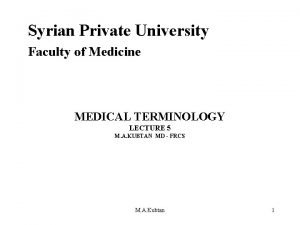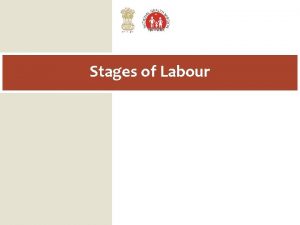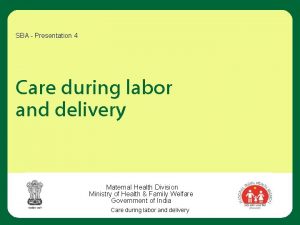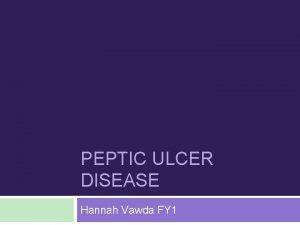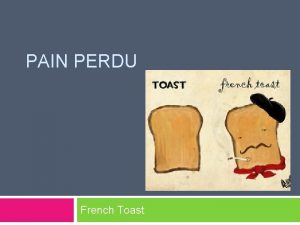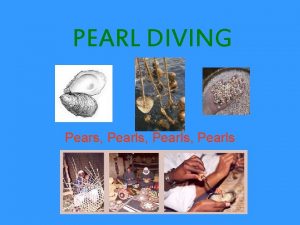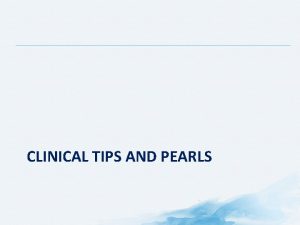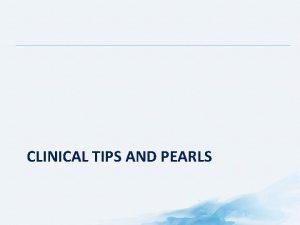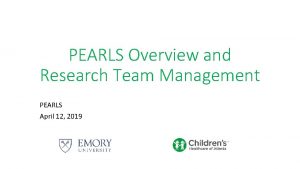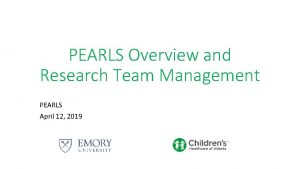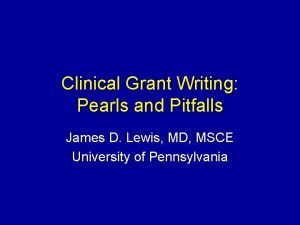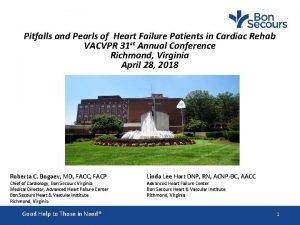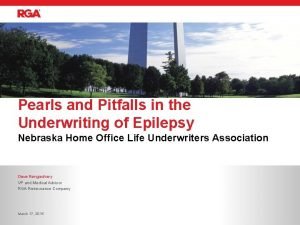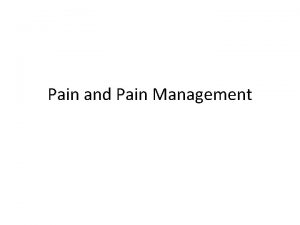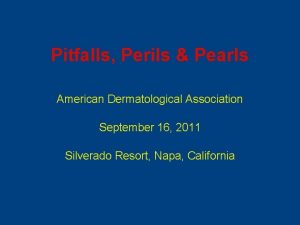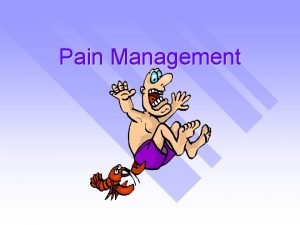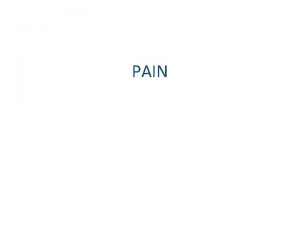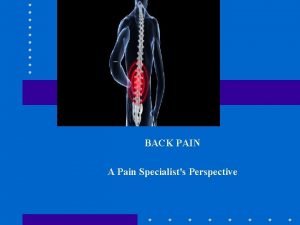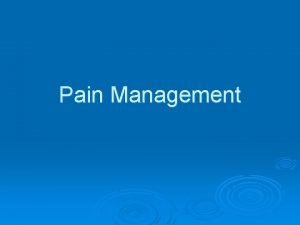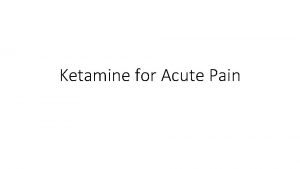Oh What a Pain Conundrums Pitfalls and Pearls
























































































































- Slides: 120

Oh What a Pain Conundrums, Pitfalls and Pearls for Treating People Living with Chronic Pain Images in this slideshow were drawn from the internet as well as generously shared by my talented patients Connie Basch, MD September 2014

Topics for this Evening Pain Physiology – a brief overview Pain Pharmacology Nutrition in Pain Mindbody Interventions

The Rules of Tacks If you are sitting on a tack, it takes a lot of aspirin to make the pain go away. If you are sitting on 2 tacks, removing one does not lead to a 50% improvement in symptoms. -Sid Baker, M. D.

Understanding Pain

Acute Pain Adaptive: Indicates tissue injury Makes you get to safety

Chronic Pain Tissue no longer at risk Pain signaling persists Maladaptive: Ongoing message is harmful, not protective

Effects of Chronic Pain Physical Psychological Spiritual

Effects of Chronic Pain Physical Stress of chronic pain Interrupted sleep Poor wound healing Decreased immunity Psychological Spiritual

Effects of Chronic Pain Physical Psychological Emotional suffering Depression Isolation Self-medication Spiritual

Effects of Chronic Pain Physical Psychological Spiritual Reminder of mortality At times perceived as a punishment or evidence of moral wrongdoing Causes feelings of powerlessness Hopelessness

Effects of Chronic Pain Under-treatment of CNP is common. In one survey, 50% of CNP patients complained of inadequate pain relief and had considered suicide to escape the unrelenting agony of their pain.

So What Can We Do? Change Pain Perception

Imagine. . . The brain has messages coming in and has caller ID. It can screen calls Some callers are filtered out altogether Some callers are amplified The messages reaching the brain depend not just on what is happening in the outside world, but also on how the messages are transmitted.

Pain Perception: the plot thickens Periphery Sensory Nerves A-delta Fibers –well-localized and rapid message, respond to tissue pressure. Fatigue with repeated stimulation. C Fibers –respond to noxious thermal, mechanical, or chemical stimuli. Slow message, poorly localized. Sensations are perceived as dull, aching, burning, and have input that does not fatigue or extinguish with repeated stimulation. Sensitization – chemical mediators from inflammation or injured tissue can sensitize small fibers, so that non-painful stimuli will be perceived as painful.

Pain Perception Spinal Cord

Pain Perception Spinal Cord Modulation: multiple signals coming in from periphery Multiple messages coming down from the brain Inhibition Serotonin Norepinephrine Endorphin Amplification

Pain Transmission Mechanism/Theory Many Points of Intervention Don’t worry – no test on this

Pain Transmission Mechanism/Theory Opioids Endorphins

Gate Control Implications: Mechanical Stimuli Can Decrease Pain Sensation Chronically firing pain neurons can be “silenced” by intense mechanical stimuli. Boal RW, Gillette RG. Central neuronal plasticity, low back pain and spinal manipulative therapy. J Manipulative Physiol Ther. 2004 Jun; 27(5): 314 -26

Pain Transmission Mechanism/Theory Infection Inflammatory Diet Substance P Capsaicin Massage Chiropractic

Pain perception Brain Can amplify or suppress the messages coming in Gives meaning to the pain experience Differences in pain levels of victims of automobile accidents vs. those responsible for the accident Carolyn Myss insights, etc. John Sarno and repressed anger

Gate Control Mechanism/Theory Nutrition Mind-Body Therapies Opioids Topical treatments Adjunctive Medications Physical Therapies

Topics for this Evening Pain Physiology – a brief overview Pain Pharmacology Nutrition in Pain Mindbody Interventions

Symptom Management: Medical Treatment of Pain WHO's pain ladder - developed for cancer pain, now applied for nonmalignant chronic pain as well

Step 1: Non-Opioid Analgesics Aspirin Tylenol Other NSAIDs

Tylenol(acetaminophen) toxicity Chronic tylenol ingestion of 4000 mg per day (8 vicodin) can produce liver damage Lower doses can be toxic when fasting/not eating well or if taken with alcohol Extra strength tylenol has 500 mg Vicodin, norco, lortab have from 325 – 750 mg per tab Many cold and flu medicines have acetaminophen in them as well

Adverse effects of NSAIDs (Anti-inflammatory drugs): Stomach and GI tract Ulcers and internal bleeding Leaky Gut: Increased intestinal permeability Bones and Joints Bone necrosis and cartilage destruction Inhibition of cartilage synthesis Other organs Liver damage Kidney injury Death

NSAIDs and the Stomach 107, 000 patients hospitalized per year for stomach complications 16, 500 NSAID‐related deaths occur each year among arthritis patients Am J Med. 1998 Jul 27; 105(1 B): 31 S-38 S

The “safer” anti-inflammatories?

NSAIDs Block Joint Repair In vivo studies with NSAIDs at physiologic concentrations have shown that several NSAIDs reduce glycosaminoglycan synthesis. Salicylate Acetylsalicylic acid Fenoprofen Isoxicam Tolmetin Ibuprofen “…femoral head collapse and acceleration of osteoarthritis have been well documented in association with the NSAIDs…” Lancet. 1985 Jul 6; 2(8445): 11 -4

Another non-narcotic option: Devil’s Claw Harpagophytum procumbens (Devil’s claw) – 60 mg harpagoside per day Primarily analgesic, not much anti-inflammatory activity; in one study was as effective as vioxx for low back pain Try for 4 -8 weeks

Tramadol = Ultram Milder version of an opioid Morphine and others bind to kappa and mu opioid receptors Tramadol binds to kappa but not mu Less addictive potential Works better in women than men Risk of seizures in excessive doses or in combination with some antidepressants

Opioids in Chronic Pain Management Benefits and Risks

Unintentional Drug Overdose Deaths In 2007, there were over 28, 000 unintentional drug overdose deaths in this country

Opioids in Chronic Nonmalignant Pain Side effects: constipation, sleep disruption, altered mental status, itching, nausea, respiratory depression Addiction vs. Dependence Bottom line: Assessing whether medication improves quality of life and participation in life or diminishes them

Questions to Ask Before Starting: Have there been any other chemical (alcohol or drug) abuse problems in the person’s life? Is there a family history of substance abuse? Is there a history of sexual abuse prior to adolescence? Is there psychological disease? (Depression, bipolar, OCD, ADHD, etc. )

Signs Someone is Being Harmed more than Helped by Pain Medication Sleeping too much or having days and nights confused Decrease in appetite Inability to concentrate or short attention span Mood swings (especially irritability) Lack of involvement with others Difficulty functioning Therapists may be in a unique position to observe this and give feedback to prescribers

Questions for Patient Self-reflection: Is your day centered around taking medication? Do you spend most of the day resting, avoiding activity, or feeling depressed? Are you able to function (work, household chores, and play) with pain medication in a way that is clearly better than without?

Proper use of opioid pain medications

Timing Short-acting/Rescue medications: codeine, hydrocodone, oxycodone, morphine Drug level time 3 -4 hours 30 -60 minutes

Problems with Short-acting Medications Drug level Loaded In pain Time

Long-acting narcotics: Drug level Time Fentanyl patches (Duragesic) Methadone MS Contin Oxy. Contin Need to be dosed on a schedule, not prn

Opioid-induced Hyperalgesia Animal studies show that repeated opioid administration. . . can lead to a progressive and lasting reduction of baseline nociceptive thresholds, resulting in an increase in pain sensitivity. The decreased baseline nociceptive thresholds lasted as long as 5 days after the cessation of four fentanyl bolus injections

Opioid-induced Hyperalgesia Six chronic low back pain patients Quantitative sensory testing (cold and heat) before and after starting oral morphine Preliminary results showed hyperalgesia and tolerance with cold but no hyperalgesia with heat or analgesic tolerance to heat pain. Chu L. F. , Clark D. J. , Angst M. S. : Opioid tolerance and hyperalgesia in chronic pain patients after one month of oral morphine therapy: a preliminary prospective study. J Pain 7. (1): 43 -48. 2006

Opioid-induced Hyperalgesia A number of case reports document decreases in pain with stopping opioids Wilson G. R. , Reisfield G. M. : Morphine hyperalgesia: a case report. Am J Hosp Palliat Care 20. (6): 459 -461. 2003 Mercadante S. , Ferrera P. , Villari P. , et al: Hyperalgesia: an emerging iatrogenic syndrome. J Pain Symptom Manage 26. (2): 769 -775. 2003; Heger S. , Maier C. , Otter K. , et al: Morphine induced allodynia in a child with brain tumour. BMJ 319. (7210): 627 -629. 1999; Sjogren P. , Jensen N. H. , Jensen T. S. : Disappearance of morphine-induced hyperalgesia after discontinuing or substituting morphine with opioid agonists. Pain 59. 313 -316. 1994; Mechanism may be NMDA receptor-mediated central sensitization

So why/when use them? Opioids are most helpful in Acute Pain In Chronic Pain, I recommend them as a bridge: Premedicate to increase activity level Medicate to get good, deep sleep As sleep improves and activity improves, try to wean

Stopping or Tapering Opioids Withdrawal Symptoms Anxiety/Restlessness Sweating Insomnia Diarrhea Nausea, vomiting Yawning, rhinorrhea (runny nose) Transient increase in pain

Treatment of Withdrawal Each of the symptoms of withdrawal can be treated, and herbal support is also available for opioid withdrawal Suboxone Passionflower Clonidine Lomotil Hydroxyzine Trazodone Etc.

Adjunctive Medications Topical – lidocaine, capsaicin, anti-inflammatories, other Antidepressants Anticonvulsants Antiarrhythmic drugs Cannabis

Adjunctive Therapies Mind-Body Therapies Nutrition Magnesium Adjunctive Medications Antidepressants Cannabis? Opioids Seizure Medications Topical treatments Substance P Anti-inflammatory Turmeric Lidocaine Capsaicin Physical Therapies

Antidepressants for Pain Work by affecting neurotransmitters Do not only work for treating pain by improving depression. Work as well in non-depressed people as in people with depression Effectiveness for pain does not correlate with effectiveness for depression Do not work for all types of pain.

Cannabis in Pain Cannabis is more effective than placebo in chronic pain, especially neuropathic and MS-related pain and spasticity As an adjunct to opioids, THC improved pain-related QOL May be opioid-sparing and may decrease tolerance and withdrawal from opioids Significant side effects, esp dizziness, can be seen Euphoria NNH 8 Works on CB 1 receptors in periaqueductal gray but also G protein receptors and transient receptor potential channels (other cannabinoids, not just CBD, THC) – strain matters Pharmacotherapy 2013; 33(2): 195– 209 J Psychoactive Drugs, 44 (2), 125– 133, 2012 Current Medical Research and Opinion, 2007; 23, (1) p 17, (17 -24) Pain Medicine, 2009; 10, (8) p 1353, (1353 -1368)

Topics for this Evening Pain Physiology – a brief overview Pain Pharmacology Nutrition in Pain Mindbody Interventions

The Research Supports: Vegetarian or Vegan Diet A 3 -week vegetarian diet in FMS patients Decrease pain scores – in 19 of 30 participants Decrease blood test markers of inflammation Similar studies in RA and related conditions BMC Complement Altern Med. 2001; 1: 7 Plant Foods Hum Nutr. 1993 Jan; 43(1): 55 -61 Scandinavian Journal of Rheumatology Volume 29, Number 5 / October 27, 2000 Bangladesh Med Res Counc Bull. 2000 Aug; 26(2): 41 -7. Toxicology. 2000 Nov 30; 155(1 -3): 45 -53.

What foods to eat : fresh fruits, salads, raw vegetables, carrot juice, nuts, seeds, whole grain products, tubers, flax seed oil, extra virgin olive oil What foods to avoid: alcohol, caffeine, foods containing refined sugar, corn syrup, refined and/or hydrogenated oil, refined flour, dairy, eggs, and all meat


Making Changes in What We Eat Stages of Change: Big lifestyle changes like a change in the diet require preparation, emotional as well as logistical Generally easier to add “good” foods than to eliminate the “bad” ones we crave

The Healthy Plate

The Rules of Tacks If you are sitting on a tack, it takes a lot of aspirin to make the pain go away. If you are sitting on 2 tacks, removing one does not lead to a 50% improvement in symptoms. -Sid Baker, M. D.

Dietary Tacks Sugar Bad Fats Excitotoxins Food Allergies

Sugar (and high GI foods) Feeds bad flora (yeast and other baddies) Insulin causes weight gain causes storage of carbs rather than burning them as fuel Reactive hypoglycemia causes stress hormone release Fibrofog – memory problems, decreased concentration Exacerbation of trigger points Mood swings and irritability Sleep disturbance Fluid retention Carbohydrate craving

Bad Fats Saturated fats (animal fat – butter, lard, meat, etc. ) Probably coconut oil as well Omega-6 vegetable oils (corn oil, safflower oil, etc. ) Trans Fats - “hydrolyzed” Contribute to inflammation – raw materials for prostaglandins

MSG and Aspartame - Excitotoxins Stimulate the glutamate receptors Latter may generate formaldehyde Relief of fibromyalgia symptoms following discontinuation of dietary excitotoxins JD Smith, CM Terpening, SO Schmidt, and JG Gums BACKGROUND: Fibromyalgia is a common rheumatologic disorder that is often difficult to treat effectively. CASE SUMMARY: Four patients diagnosed with fibromyalgia syndrome for two to 17 years are described. All had undergone multiple treatment modalities with limited success. All had complete, or nearly complete, resolution of their symptoms within months after eliminating monosodium glutamate (MSG) or MSG plus aspartame from their diet. Complementary Health Practice Review, Vol. 8, No. 3, 234 -245 (2003)

What has Aspartame? Nutrasweet Diet Coke and other diet soda Crystal Light Sugar-free yogurt Sugar-free gum Etc. . .

MSG Chinese Food Many packaged foods – labeled as “Natural Flavoring” Sodium caseinate Textured protein Etc.

Food Allergies Cause Leaky Gut, which causes: Increased inflammation in the system with C fiber sensitization Immune activation which may contribute to autoimmune disease Malabsorption of nutrients, which causes malnutrition

Food Sensitivities One third of the patients with rheumatoid arthritis, ankylosing spondylitis and psoriatic arthropathy reported aggravation of disease symptoms after intake of certain foods while 43% of the patients with juvenile rheumatoid arthritis and 42% of the patients with primary fibromyalgia stated the same. . Less pain and stiffness were reported by 46% of the patients and 36% reported reduced joint swelling when these were avoided Clin Rheumatol. 1991 Dec; 10(4): 401 -7. Diet and disease symptoms in rheumatic diseases--results of a questionnaire based survey. Haugen M, Kjeldsen-Kragh J, Nordvag BY, Forre O.

Topics for this Evening Pain Physiology – a brief overview Pain Pharmacology Nutrition in Pain Mindbody Interventions

Mindbody Interventions Stress and Pain Relaxation Techniques Focus on the Positive Sarno, Schubiner – Addressing pain generated by the mind

Emotions, & Stress Causing Pain Muscle Tension Stress Neurogenic Inflammation Poor sleep

Vicious Cycle

Vicious Cycles Poor Sleep Stress Decreased GH Increased cortisol Pain Decreased Tissue Repair

Mindbody Interventions Stress and Pain Relaxation Techniques Focus on the Positive Sarno, Schubiner – Addressing pain generated by the mind

The Relaxation Response Counterbalancing mechanism to the F/F/F Response Sympathetic versus Para sympathetic nervous System Metabolism Heart rate Blood Pressure Breathing Rate Muscle Tension May be consciously elicited Generally needs to be practiced

Pearls for Relaxation Techniques in people with pain Everyone is different We offer a cafeteria style – lots of options, a “no thank- you” helping of each Breathing Guided Imagery and focused healing Mindfulness and the detached observer EFT Caveat: We have found PMR NOT to be well-accepted

Fibromyalgia – 8 weeks 70 60 50 40 30 Pre 20 Wait list 10 EFT n y io et D ep re ss xi An AD io ot m H na l y -E le al lit ta Vi Ro Ro le -P hy SF sic -3 6 0 Integrative Medicine • Vol. 7, No. 4 • Aug/Sep 2008

All p<0. 001 E ity iv Ac t ag em ng en t . . . e nc ta ep n es s sn el pl es H A cc in Pa c ni ro Ch tio ca n io at in ifi ag n m Ru ca le S ng zi hi M op tr as at C Pa in 45 40 35 30 25 20 15 10 5 0 Pre Wait list EFT

Tension Headache Times performed in 2 months Also improved sleep, decreased perceived stress Explore 2013; 9: 91 -99.

Mindbody Interventions Stress and Pain Relaxation Techniques Focus on the Positive Sarno, Schubiner – Addressing pain generated by the mind

Changing Focus to the Positive Self-portrait exercise CBT – David Burns’s Work Gratitude Forgiveness Changing the Channel Rewriting the victim story The power of groups

Self Portrait Exercise Draw a picture of you and your pain, using any medium, or describe this in words Then draw or describe yourself as you intend to be in the future, with healing








Changing Focus to the Positive Self-portrait exercise CBT – David Burns’s Work Gratitude Forgiveness Changing the Channel Rewriting the victim story The power of groups

Cognitive Distortions in Pain Catastrophization in particular is associated with worse prognosis in patients

Changing Focus to the Positive Self-portrait exercise CBT – David Burns’s Work Gratitude Forgiveness Changing the Channel Rewriting the victim story The power of groups

Gratitude An affirming of goodness or “good things” in one’s life The recognition that the sources of this goodness lie at least partially outside the self. Gratitude Journaling vs. Journals re: hassles, neutral events exercised more regularly reported fewer physical symptoms felt better about their lives as a whole were more optimistic about the upcoming week Gratitude as a Psychotherapeutic Intervention J. Clin. Psychol: In Session 69: 846– 855, 2013

Changing Focus to the Positive Self-portrait exercise CBT – David Burns’s Work Gratitude Forgiveness Changing the Channel Rewriting the victim story The power of groups

Forgiveness – of others and self Changing the Channel Rewriting the victim story Fred Luskin, Forgive for Good A forgiveness intervention for women with fibromyalgia who were abused in childhood: A pilot study. Spirituality in Clinical Practice, Vol 1(3), Sep 2014, 203 -217.

Changing Focus to the Positive Self-portrait exercise CBT – David Burns’s Work Gratitude Forgiveness Changing the Channel Rewriting the victim story The power of groups

Why Do Pain Groups? Help patients get better Provide services not otherwise covered Break isolation Facilitate development of support system (other than you!) Decrease provider burnout Make care for challenging patients cost-effective

Help Patients Get Better A multitude of studies show improved outcomes for chronic pain patients treated with cognitive behavioral therapy and with multidisciplinary interventions The combined psychological treatment and physiotherapy condition displayed significantly greater improvement. . . These differences were maintained at 6 month follow-up. Pain. 1992 Mar; 48(3): 33947. Physical symptoms: CBT-treated pts improved more than control subjects in 71% of the studies and showed possibly greater improvement (i. e. , a trend) in another 11% of the studies. Psychother Psychosom 2000; 69: 205– 215

Mindfulness-based stress reduction for failed back surgery syndrome Statistically significant and clinically significant: Increase in pain acceptance and quality of life Decrease in functional limitation Decrease in pain level Decrease in frequency, potency of analgesics Increase in sleep quality J Am Osteopath Assoc. 2010 Nov; 110(11): 646 -52

Why Do Pain Groups? Help patients get better Provide services not otherwise covered Break isolation Facilitate development of support system (other than you!) Decrease provider burnout Make care for challenging patients cost-effective


“Being with other people who understand what it is to live with constant pain that has no end in sight and sharing our experiences in a safe environment has ended my feeling of isolation” The Buddy System – homework includes checking in with buddy daily about relaxation exercises

Why Do Pain Groups? Help patients get better Provide services not otherwise covered Break isolation Facilitate development of support system (other than you!) Decrease provider burnout Make care for challenging patients cost-effective



Why Do Pain Groups? Help patients get better Provide services not otherwise covered Break isolation Facilitate development of support system (other than you!) Decrease provider burnout Make care for challenging patients cost-effective

After a behavioral medicine intervention: 36% reduction in clinic visits in the first year postintervention Projected to an estimated net savings of $12, 000 for the first year of the study posttreatment and $23, 000 for the second year Caudill et al Pain 45(1991) 334 -5


Course Format Introductory Session: didactic (We will drone on and on) Future groups more interactive/experiential: Relaxation Response Exercise Check-in Medical Presentation CBT exercise Med check Closure/Relaxation Response

Mindbody Interventions Stress and Pain Relaxation Techniques Focus on the Positive Sarno, Schubiner – Addressing pain generated by the mind

Sarno 1982 177 random patients surveyed 76% stated that they were leading normal and effectively pain-free lives 1987 109 random patients with herniated disc on CT 88% stated that they were free of pain one to three years after TMS treatment Schechter Cohort of 51 chronic back pain patients, average pain duration 9 years 54% reduction in the average pain intensity scores Alternative Therapies in Health and Medicine 13 (5): 26– 35

MRI and Back Pain Magnetic Resonance Imaging of the Lumbar Spine in People without Back Pain MRI examinations on 98 asymptomatic people Only 36% had a normal MRI 52% - bulge at at least one level 27% - protrusion 1% - extrusion. 38% - abnormality of more than one intervertebral disk. “Given the high prevalence of these findings and of back pain, the discovery by MRI of bulges or protrusions in people with low back pain may frequently be coincidental” Maureen C. Jensen, et al. NEJM Volume 331: 69‐ 73, 1994

Predictors of Low Back Pain in People with Asymptomatic Abnormal MRI’s Forty-six asymptomatic individuals who had a high rate of disc herniations (73%) were observed for an average of 5 years Low back pain was predicted by (P < 0. 001): listlessness job satisfaction working in shifts NOT by abnormal discs Boos et al. Spine. 25(12): 1484 -1492, June 15, 2000.

Why Would the Brain Cause Pain? Freud’s theory: punishment for unacceptable feelings (usually sexual) Sarno’s theory: Defense Parts of your mind may think they need to protect you from dangerous or threatening feelings

TMS Conscious Repression Unconscious unaware

Sources of Rage Childhood/Historical Trauma Personality Traits – Self-imposed pressures Current Life Pressures

Who Gets Chronic Pain, and When? Historical Features Trauma in early life Trauma/victimization at time of onset Personality traits Perfectionism “Good-ism” Driven people Current stresses Not uncommonly, onset is related to a stressful event/relationship/job/etc.

The Prescription 1. Understand the true cause of the pain is this process, not the structural abnormalities 2. Reflect on this every day. Read a portion of one of Sarno’s books, read my handout, etc. Spend 30 -60 minutes on this daily. 3. Think psychological, not physical 4. Talk to your brain.

Write! 2. Remember the purpose of the pain is to distract you from feelings that are considered dangerous, like rage, hurt, sadness, sorrow, guilt, or fear. These are feelings we are not aware of. Make a list of all the important factors in your life that might be contributing to your pain. Write an essay about each one. Also, divorce, loss of a parent, etc.

Other Work on Journal Writing When individuals are asked to write or talk about personally upsetting experiences, significant improvements in physical health are found Those who do best: Use a higher proportion of negative emotion words than positive emotion words Increase use of insight, causal, and associated cognitive words over several days of writing Behav Res Ther. 1993 Jul; 31(6): 539 -48. Putting stress into words: health, linguistic, and therapeutic implications. Pennebaker JW.

Take-homes Look for tacks There is more to treat pain than pain pills People are different Be open to paradoxes Pain medication can increase or decrease pain Yogurt can heal one person’s gut and cause another person migraines A gratitude journal and an anger journal can each be helpful Mindfulness and Imagery (being present or leaving the body) can each be helpful
 Lewis mad pain and martian pain
Lewis mad pain and martian pain Breast tenderness early pregnancy
Breast tenderness early pregnancy Pms or pregnancy
Pms or pregnancy C traps and pitfalls
C traps and pitfalls The perils and pitfalls of leading change case solution
The perils and pitfalls of leading change case solution About coriander
About coriander Simile in the poem taj mahal
Simile in the poem taj mahal Latchup in vlsi
Latchup in vlsi Discuss pitfalls in differentiation.
Discuss pitfalls in differentiation. What are two pitfalls (problems) of lock-based protocols
What are two pitfalls (problems) of lock-based protocols Pitfalls adalah
Pitfalls adalah Pitfalls in relational database design tutorialspoint
Pitfalls in relational database design tutorialspoint Graph based locking protocol
Graph based locking protocol What are two pitfalls (problems) of lock-based protocols
What are two pitfalls (problems) of lock-based protocols Pitfalls of operator overloading in c++
Pitfalls of operator overloading in c++ Pitfalls of object oriented programming
Pitfalls of object oriented programming Security handshake pitfalls
Security handshake pitfalls Forward elimination
Forward elimination Strategic management process
Strategic management process The pitfalls of a differentiation strategy include
The pitfalls of a differentiation strategy include Pitfalls of prototyping
Pitfalls of prototyping Circuit pitfalls in vlsi
Circuit pitfalls in vlsi Pitfalls in selecting new ventures
Pitfalls in selecting new ventures Concurrency control mechanisms
Concurrency control mechanisms Pave checklist
Pave checklist Pearl symbolism meaning
Pearl symbolism meaning Ob gyn pearls
Ob gyn pearls Mel.np
Mel.np Gensvarsmodel
Gensvarsmodel Rumus shu
Rumus shu Stat pearls impact factor
Stat pearls impact factor Magma coral bells
Magma coral bells Pearls of sicily lido di noto
Pearls of sicily lido di noto Analisis pearls
Analisis pearls Natural pearls are found in which creature
Natural pearls are found in which creature Plastic packing pearls
Plastic packing pearls Clinical pearls
Clinical pearls Pharmacy clinical pearls
Pharmacy clinical pearls Modified bassini repair
Modified bassini repair Pain scale with words
Pain scale with words Iv site complications
Iv site complications Signs of phlebitis vs infiltration
Signs of phlebitis vs infiltration Chapter 7 nursing management of pain during labor and birth
Chapter 7 nursing management of pain during labor and birth Chapter 31 comfort rest and sleep
Chapter 31 comfort rest and sleep Cervical facet referral patterns
Cervical facet referral patterns Ferratima
Ferratima Comfort and pain management fundamentals of nursing
Comfort and pain management fundamentals of nursing Sinus cavernosus
Sinus cavernosus Presenting complaint
Presenting complaint Referred pain definition
Referred pain definition Le pain que tu nous donnes
Le pain que tu nous donnes Societal impact of pain
Societal impact of pain University hospital of pisa
University hospital of pisa Pain management okc soonercare
Pain management okc soonercare Remains poem by simon
Remains poem by simon When was remains poem written
When was remains poem written Prostate referred pain
Prostate referred pain Diagramme fast exemple
Diagramme fast exemple Cpot pain scale
Cpot pain scale Example of pico question
Example of pico question Chest pain in pediatrics
Chest pain in pediatrics Pqrst pain assessment
Pqrst pain assessment Unpleasant sensory
Unpleasant sensory What is pain jeopardy
What is pain jeopardy Children's pain scale
Children's pain scale Pain management stony brook
Pain management stony brook Opqrst
Opqrst How to use abbey pain scale
How to use abbey pain scale Flacc scale kkm
Flacc scale kkm Ms pain points
Ms pain points Npass tool
Npass tool Coat hanger pain
Coat hanger pain Through labor pain
Through labor pain Pain de vie corps ressuscité
Pain de vie corps ressuscité Suc digestif
Suc digestif Nccpc pain scale
Nccpc pain scale Iu health pain management
Iu health pain management Typical vs atypical chest pain
Typical vs atypical chest pain Tca mechanism of action pain
Tca mechanism of action pain Painad
Painad Gbmc pain management
Gbmc pain management Inflammatory vs mechanical joint pain
Inflammatory vs mechanical joint pain Acute abdomen
Acute abdomen Hodgkin's lymphoma alcohol pain
Hodgkin's lymphoma alcohol pain Types of pain
Types of pain Hypocholic
Hypocholic Headache nursing management
Headache nursing management Mason liker
Mason liker Chanson du pain et des roses
Chanson du pain et des roses Intertragal notch pain
Intertragal notch pain Seigneur nous venons tous t'offrir le pain
Seigneur nous venons tous t'offrir le pain Au bon catering
Au bon catering Cries pain scale
Cries pain scale Chest pain in pediatrics
Chest pain in pediatrics Ceo pain
Ceo pain Ruben gonzalez vallina
Ruben gonzalez vallina Pqrst pain scale
Pqrst pain scale Pain intensity scales
Pain intensity scales Non verbal pain scale pdf
Non verbal pain scale pdf Hypogastric pain causes
Hypogastric pain causes Colonnoscopy
Colonnoscopy Lifeaat
Lifeaat Referred pain from appendicitis
Referred pain from appendicitis Llq pain
Llq pain Right upper quadrant pain
Right upper quadrant pain Divericulitis
Divericulitis Ruq
Ruq Little league shoulder pain location
Little league shoulder pain location Pqrstu pain assessment
Pqrstu pain assessment Total pain
Total pain Vision gives pain a purpose
Vision gives pain a purpose Real contractions vs false labor
Real contractions vs false labor Primary control vs secondary control
Primary control vs secondary control Crine medical terminology
Crine medical terminology Symbole de l'eau dans la bible
Symbole de l'eau dans la bible True labour pains
True labour pains True labor pains
True labor pains Oucher scale
Oucher scale Discogenic low back pain
Discogenic low back pain Alarm signs of pud
Alarm signs of pud Pain perdu histoire
Pain perdu histoire



